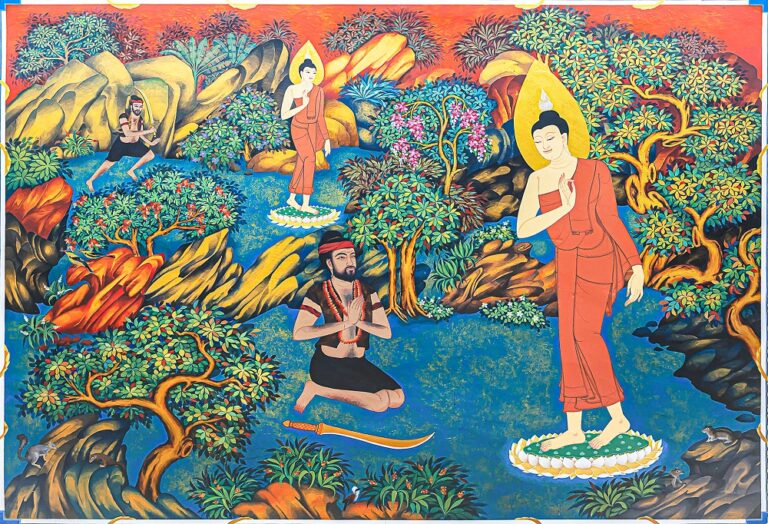
THE CONVERSION OF ANGULIMALA
The name Angulimala means “finger necklace,” or a necklace made of the fingers of the murderer’s victims. Angulimala personifies indiscriminate violence and unconcern for the sanctity of living beings.
Angulimala was born to a good and noble family, but he was born under the omen of the thief. For that reason, his parents originally named him Ahimsaka, or “harmless.” He was a strong, smart, and well-behaved boy, so his parents thought they had successfully removed all the evil from him.
But when Ahimsaka went to university, he became the teacher’s favourite student. The other students were very jealous of him, and they decided to convince the teacher that Ahimsaka was plotting against him. They persisted until the teacher became so suspicious that he decided to get rid of Ahimsaka.
As it was common for teachers to receive gifts from their students, the teacher asked Ahimsaka to bring him 1000 little human fingers from the right hand. He assumed that Ahimsaka would be arrested—or even killed—in the process of getting the fingers, and his worries would be over.
Ahimsaka went into the forest with a knife. He found a high cliff to live on, where he could see the trade route below. Whenever he spotted a traveller, he would murder them and cut off the little finger of their right hand. He strung all the fingers he had collected into a necklace. (which can be seen in this mural). As a result, he became known as Angulimala.
Soon, no one passed through the forest anymore, so Angulimala ventured into towns and murdered people in their homes. The villagers left and went to the capital city, begging the King to do something. The King decided to capture and kill Angulimala.
When Angulimala’s mother heard this, she ran into the forest to warn her son. Angulimala had collected 999 fingers, and needed only one more to complete his gift. He would even murder his own mother.
But the Buddha became aware of this situation, and walked to where Angulimala was hunting his victims. Many people warned the Buddha that he was in danger, but he continued on.
Angulimala was chasing his own mother when the Buddha intervened, and Angulimala began chasing him instead. Yet no matter how fast Angulimala ran, he could not catch the Buddha, who was walking at a normal pace. He shouted at the Buddha to stop, but the Buddha only replied, “I have stopped, Angulimala. You stop.”
Angulimala stopped, but the Buddha continued walking. Angulimala asked the Buddha, “How can you say I have not stopped, when I have? And how can you say you have stopped, when you are still walking?”
The Buddha answered him: “I have stopped by ending all violence towards living beings.” With that, Angulimala suddenly ended his violent ways, and became a monk.
King Pasenadi had vowed to kill Angulimala as soon as he was caught, as punishment for his crimes. However, the Buddha asked the King if he would still punish him if Angulimala renounced his ways and became a monk? The Buddha led the King to understand the difference between those who are actively violent and those who are not. The King changed his thinking in response to the Buddha’s questioning, and resolved to protect Angulimala if he changed his ways.
This story therefore demonstrates the change of heart of both the criminal and the prosecutor, and the redemptive power of the Buddha’s teaching. It shows the potential of Buddhist teachings to curb humanity’s worst tendencies and turn even the most violent criminals into nonviolent beings.